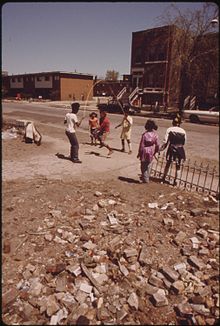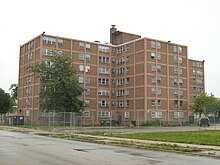Ida B. Wells Homes
| Ida B. Wells Homes | |
|---|---|
 Building within the Ida B. Wells Homes seen from East Oakwood Boulevard and South Cottage Grove Avenue, 1978. | |
 | |
| General information | |
| Location | Bounded by 35th Street, Pershing Road, King Drive, and Cottage Grove Avenue Chicago, Illinois |
| Status | Demolished |
| Construction | |
| Constructed | 1939–41; Ida B. Wells Homes 1961; Darrow Homes 1970; Madden Park Homes |
| Demolished | 2002–11 |
| Other information | |
| Governing body | Chicago Housing Authority (CHA) |
The Ida B. Wells Homes, which also comprised the Clarence Darrow Homes and Madden Park Homes, was a Chicago Housing Authority (CHA) public housing project located in the heart of the Bronzeville neighborhood on the South Side of Chicago, Illinois. It was bordered by 35th Street to the north, Pershing Road (39th Street) to the south, Cottage Grove Avenue to the east, and Martin Luther King Drive to the west. The Ida B. Wells Homes consisted of rowhouses, mid-rises, and high-rise apartment buildings, first constructed 1939 to 1941 to house African American tenants. They were closed and demolished beginning in 2002 and ending in 2011.
History[edit]

Named for African American journalist and newspaper editor Ida B. Wells,[1] the housing project was constructed between 1939 and 1941 as a Public Works Administration project to house black families in the "ghetto", in accordance with federal regulations requiring public housing projects to maintain the segregation of neighborhoods.[2][3][4] It was the fourth public housing project constructed in Chicago before World War II and was much larger than the others, with 1,662 units.[2] It had more than 860 apartments and almost 800 row houses and garden apartments,[1] and included a city park, Madden Park. Described as "handsome [and] well planned", the project was initially a sought-after address and a route to success.[5][6]
Darrow Homes and Madden Park Homes[edit]
In 1961, the Clarence Darrow Homes were built adjacent to the Ida B. Wells Homes and in 1970, the last of the Chicago Housing Authority's high-rise projects, the Madden Park Homes, were built east of the Wells.[7] The "three huge, contiguous projects" lined the northern edge of the Oakland community area.[8]
Problems[edit]


Like many other Chicago housing projects, the Wells homes were plagued by problems such as neglect by the housing authority,[9] gang violence, shootings, drug abuse, and drug dealing.[10] The Black P. Stones gang in particular asserted authority over the area and residents of the Ida B. Wells Homes; Eugene Hairston, co-founder of the gang, was shot dead at his home there in September, 1988.[11] One mother-and-son cocaine ring in the project reputedly had customers standing in line "50 at a time, 'like at a Popsicle stand on a hot day'".[12] The 30-minute audio documentary Ghetto Life 101, released in 1993, was made by two teenagers from the project, LeAlan Jones and Lloyd Newman. Their second audio documentary, Remorse: The 14 Stories of Eric Morse, which won a Peabody Award,[13] deals with the murder of 5-year-old Eric Morse in the project on October 13, 1994; he was pushed from the window of a vacant 14th-floor apartment by two older boys (aged 10 and 11) after he refused to steal candy for them.[1][14][15][16] The project was also the location for Frederick Wiseman's 1997 documentary Public Housing.[17][18][19]
Demolition[edit]

In 1995, the United States Department of Housing and Urban Development took over the Chicago Housing Authority's public housing projects and decided to demolish the high-rises. Demolition began at the Ida B. Wells Homes in late 2002 with the high-rise buildings on Cottage Grove Avenue. It was completed in August 2011 with the demolition of the last two residential buildings at 3718 S. Vincennes Avenue.[20] Construction began in 2003 on the mixed-income community of Oakwood Shores, which will replace all three housing projects, Ida B. Wells, Madden Park, and Clarence Darrow,[21][22] A commission, led by Well's great grand-daughters raised funds for a public memorial to honor Wells near the site, which had also been close to Wells' own neighborhood.[1][23][24] The Light of Truth Ida B. Wells National Monument created by well known abstract sculptor and Chicago artist Richard Hunt was unveiled on June 29, 2021.[25]
See also[edit]
References[edit]
- ^ a b c d Caryn Rousseau, Associated Press, "Ida B. Wells Sculpture To Be Built In Chicago", Chicago Impact, Huffington Post, December 28, 2011.
- ^ a b Harvey M. Choldin, "Chicago Housing Authority", Electronic Encyclopedia of Chicago, Chicago Historical Society, 2005.
- ^ Kenneth J. Saltman, Capitalizing on Disaster: Taking and Breaking Public Schools, Cultural politics & the promise of democracy, Boulder, Colorado: Paradigm, 2007, ISBN 9781594513817, p. 121.
- ^ The area called Bronzeville was at one time "the heart of the African-American community in Chicago" - Peter K. B. St. Jean, Pockets of Crime: Broken Windows, Collective Efficacy, and the Criminal Point of View, Chicago: University of Chicago, 2007, ISBN 9780226774985, p. 14.
- ^ J. S. Fuerst and D. Bradford Hunt, When Public Housing was Paradise: Building Community in Chicago, Westport, Connecticut: Praeger, 2003, ISBN 9780275974978, p. 2, pp. 52–57.
- ^ Nicholas Lemann, "The Origins of the Underclass," Part One, The Atlantic, July 1986: "It is common in Chicago to meet successful blacks in their late thirties and early forties who spent part of their childhood in the projects."
- ^ Madden Wells Homes, Frank's Masonry.
- ^ Alexander Polikoff, Waiting for Gautreaux: A Story of Segregation, Housing, and the Black Ghetto, Evanston, Illinois: Northwestern University, 2005, ISBN 9780810123441, p. 295.
- ^ Tom McNamee, "Ida B. Wells - big and bad", Chicago Sun-Times, December 7, 1986.
- ^ Derek S. Hyra, The New Urban Renewal: The Economic Transformation of Harlem and Bronzeville, Chicago: University of Chicago, 2008, ISBN 9780226366043, p. 89.
- ^ Jerry Thornton and Robert Blau, "Police Say Shooting May Have Been Ordered By Rukns", Chicago Tribune, September 23, 1988.
- ^ Charles Nicodemus, "`Major, Major' Drug Ring Broken", Chicago Sun-Times, May 20, 1995.
- ^ Don Terry, "Graduation Ends a Partnership Born in a Chicago Ghetto", The New York Times, June 9, 1997, p. 2.
- ^ Remorse: The 14 Stories of Eric Morse Archived 2010-06-25 at the Wayback Machine, Sound Portraits.
- ^ 1 Remorse": Two children of the Chicago projects have made a remarkable documentary on the life and death of 5-year-old Eric Morse, killed for refusing to steal candy. Their work will be broadcast tomorrow on NPR. VOICES OF EXPERIENCE March 20, 1996
- ^ Flynn McRoberts, Julie Irwin, et al., "A Search for Answers in Eric's Fatal Fall", Chicago Tribune, October 16, 1994.
- ^ Roger Ebert, "'Housing' unlocks truth: Filmmaker lets camera tell CHA residents' story", Chicago Sun-Times, November 27, 1997.
- ^ John McCarron, "Cinema Verite: Wiseman's Unflinching Look at Life in the CHA", Chicago Tribune, November 28, 1997: "'Public Housing' was filmed entirely within the Ida B. Wells public housing complex".
- ^ Elise Nakhnikian, "Fred Wiseman Is There: Public Housing", The Measure, The L Magazine, October 15, 2010.
- ^ Jacqueline Thompson, Ida B. Wells Revisited, Residents' Journal, We The People Media, October 5, 2011.
- ^ Oakwood Shores Archived 2013-05-10 at the Wayback Machine, Chicago Housing Authority.
- ^ Oakland Archived 2012-02-13 at the Wayback Machine, South East Chicago Commission.
- ^ Ron Grossman, "Supporters propose monument to Ida B. Wells: Ex-residents of the vanished housing complex named for the civil rights pioneer call for a lasting tribute", Chicago Tribune, November 9, 2011.
- ^ Bronzeville, City to honor pioneer Ida B. Wells Archived 2013-07-26 at the Wayback Machine, Gazette Chicago, February 2, 2012.
- ^ Shaw, Nichole (2021-06-30). "Unveiling of Ida B. Wells Monument in Bronzeville met with 'joy, excitement, appreciation and humbleness'". Chicago Sun-Times. Retrieved 2021-07-03.
Further reading[edit]
| External videos | |
|---|---|
- LeAlan Jones and Lloyd Newman, with David Isay. Our America: Life and Death on the South Side of Chicago. New York: Scribner, 1997. ISBN 9780684836164. Based on the two radio documentaries Ghetto Life 101 and Remorse: The 14 Stories of Eric Morse.
- Residential buildings completed in 1941
- Residential buildings completed in 1961
- Residential buildings completed in 1970
- Demolished buildings and structures in Chicago
- Public housing in Chicago
- Urban decay in the United States
- Buildings and structures demolished in 2011
- 2011 disestablishments in Illinois
- Public Works Administration in Illinois
- 1941 establishments in Illinois
- Ida B. Wells
